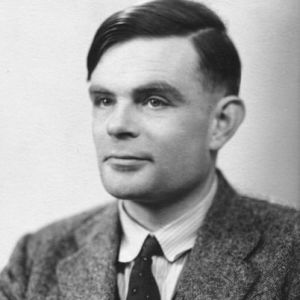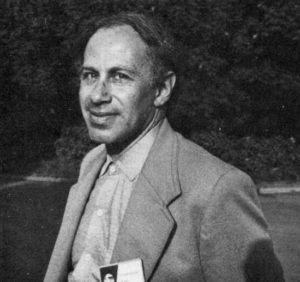
Alan Turing
In 1951, the brilliant British scientist Alan Turing published a paper proposing a theory in chemistry called morphogenesis, which explains how cells are grouped together within an organism.
According to Turing, oscillating chemical reactions predictable by mathematical formula are partially responsible for organizing cells to form organs, bone, and tissue. Of course, Turing’s greatest claim to fame was his role as the leader of the team that remarkably broke the Enigma code during World War II, the secret German code once considered unbreakable, as depicted in the excellent film The Imitation Game.
Unfortunately, Turing committed suicide only three years after his paper on morphogenesis was published, after his prosecution for the “crime” of being homosexual. Alan Turing didn’t live to see the publication of evidence that would have validated his theory almost immediately.

Boris Belousov
Only a few years after Turing’s paper on morphogenesis was published, chemist Boris Belousov mixed potassium bromate with citric acid, discovering that the blended mixture changed colors as the fluids oscillated and chemicals reacted, which seems to prove Turing’s theory. And as these videos illustrate, the phenomenon is actually very easy to replicate by experiment.
However, when Belousov attempted to have his research published in 1951, the leading scientific journals flatly rejected his work, based on the assumption that the experiment results were “impossible.”
Only a single paragraph from Belousov’s analysis was finally published four years later, in 1955. Alan Turing was already dead. And so was the career of Boris Belousov, so disgusted the editors of the leading journals had flatly rejected his work without even trying to replicate the results that he stopped performing scientific research.

Anatol Zhabotinsky
The reason his discovery is also named after Anatol Zhabotinsky is because the latter discovered Belousov’s research and performed a very similar experiment, successfully publishing the results of his work in 1968.
Zhabotinsky used a slightly different chemical solution than Belousov, substituting melonic acid for citric acid to increase the visibility of the reactions.
Because of the role he played in the discovery of the B/Z reaction, Zhabotinsky has been called the father of nonlinear chemical dynamics. But does that make Boris Belousov the grandfather?
A horribly flawed peer review process utterly failed Boris Belousov. The editors of science journals successfully asserted themselves as the arbiters of what may be considered acceptable science, and their power remains largely unchecked even today.
In reality, the contemporaries of Boris Belousov were not his peers. Fortunately (for the advancement of science, at least) Anatol Zhabotinsky was Belousov’s intellectual equal, and a true scientist who appreciated the power of discovery via experiment.
Rather than simply assuming that some process or claim is “impossible,” perhaps we should seriously consider at minimum a cursory investigation of the alleged evidence. Quid est veritas?
Opinions may change over time, but truth never changes.
Peer review is a horribly flawed system, but unfortunately, it remains the best system we have.

Excerpt: “Peer review is a horribly flawed system, but unfortunately, it remains the best system we have.”
Peer-review fuels plagiarism, which fuels ignorance when what is known about physics, chemistry, and conserved molecular mechanisms is placed back into the context of ridiculous theories and people like John Leonard refer to me as an ill-mannered idiot.
See for example my invited review of nutritional epigenetics, which was returned without review, and the subsequent publications from two guest editors of the journal “Nutrients” who requested my review: Lynnette Ferguson and Justin O’Sullivan.
Nutrient-dependent pheromone-controlled ecological adaptations: from atoms to ecosystems https://dx.doi.org/10.6084/m9.figshare.994281
Genomic instability in human cancer: Molecular insights and opportunities for therapeutic attack and prevention through diet and nutrition http://www.ncbi.nlm.nih.gov/pmc/articles/PMC4600419/
Insights from Space: Potential Role of Diet in the Spatial Organization of Chromosomes http://www.mdpi.com/2072-6643/6/12/5724/htm
I used the honeybee model organism as an example of biologically-based cause and effect in: Nutrient-dependent pheromone-controlled ecological adaptations: from atoms to ecosystems
See also: DNA methylation also occurs in the human brain and the team’s findings are key to understanding how we remember. And, how we forget.
“By understanding how changes to the epi-genome accumulate, manifest and influence brain function, we may, in the future, be able to develop treatments for brain diseases that also develop over a lifetime. There is thought to be a genetic predisposition for some conditions, such as Alzheimer’s and dementia, but in many cases environmental factors determine whether the disease will manifest,” Biergans concludes.
https://blog.frontiersin.org/2016/12/12/honeybee-memories-another-piece-of-the-alzheimers-puzzle/comment-page-1/#comment-8764
This is why I used the honeybee model organism as an example of the need for supercoiling.
DNA Supercoiling Combats Environmental Challenges http://www.labroots.com/trending/genetics-and-genomics/2805/dna-supercoiling-combats-environmental-challenges
See also: “What is life when it is not protected from virus driven entropy” https://www.youtube.com/watch?v=K35THJtlhoE Published on 30 Mar 2016
Poster: The anti-entropic force of virucidal ultraviolet light links guanine–cytosine (G⋅C) Watson–Crick base pairing from hydrogen-atom transfer in DNA base pairs in solution to supercoiled DNA, which protects the organized genomes of all living genera from virus-driven entropy. For example, protection of DNA from permanent UV damage occurs in the context of photosynthesis and nutrient-dependent RNA-directed DNA methylation, which links RNA-mediated amino acid substitutions to DNA repair. In the context of thermodynamic cycles of protein biosynthesis and degradation, DNA repair enables the de novo creation of G protein coupled receptors (GPCRs). Olfactory receptor genes are GPCRs. The de novo creation of olfactory receptor genes links chemotaxis and phototaxis from foraging behavior to social behavior in species from microbes to humans. Foraging behavior links ecological variation to ecological adaptation in the context of this atoms to ecosystems model of biophysically constrained energy-dependent RNA-mediated protein folding chemistry. Protein folding chemistry links nutrient-dependent microRNAs from microRNA flanking sequences to energy transfer and cell type differentiation in the context of adhesion proteins, and supercoiled DNA that protects all organized genomes from virus-driven entropy.
An article published in print yesterday links Turing’s claims about oscillations and instability from the energy-dependent transfer of hydrogen-atoms in DNA base pairs in solution to all biophysically constrained biodiversity in the context of energy as information, which serious scientists know must be linked from the physiology of reproduction to supercoiled DNA in all living genera.
Since you are not responding here, I am not going to post anything else. You may want to comment on my FB group, which is where Peter Berean is asserting his claims about “bio-functional information,” or on my domain RNA-mediated.com